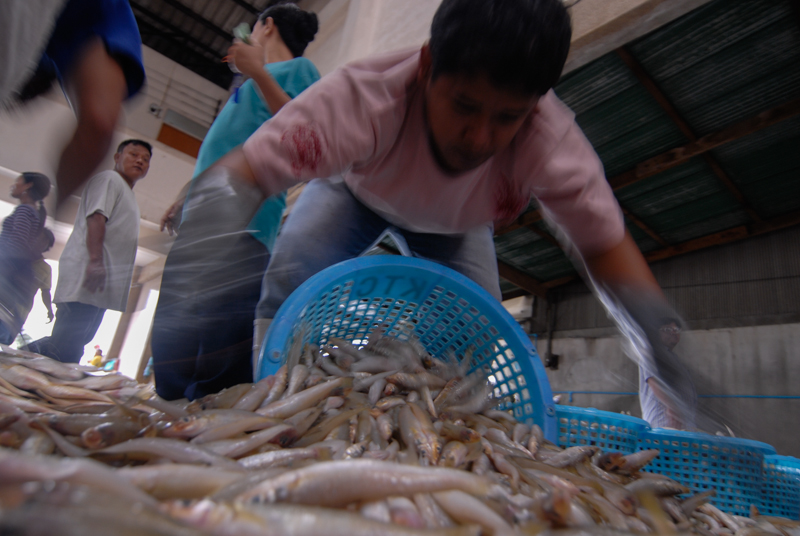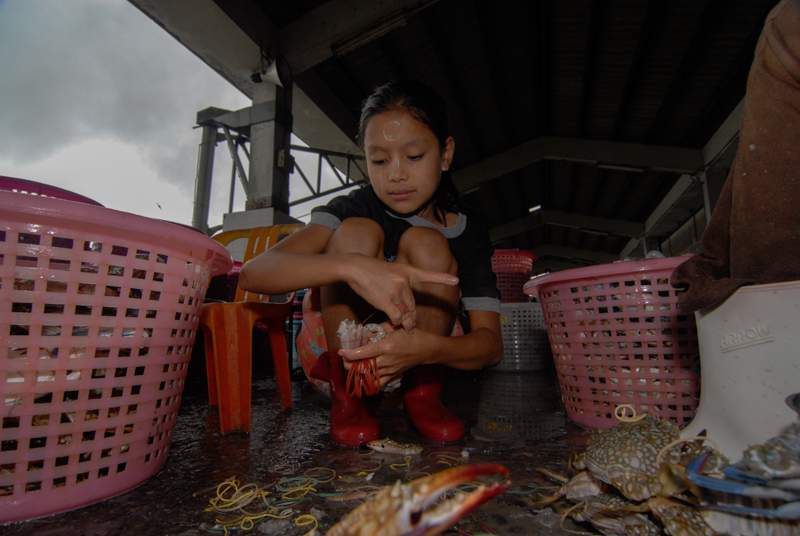[dropcap]I[/dropcap]t started with a nameless phone number passed around until it got to Ngwe Htay, a Mon State native who lived on a farm until an electrical fire wiped it away in a quick sweep of misfortune.
The man on the phone promised jobs for his family in a Chinese-owned seafood processing plant, for a fee of US$400 each. They would be transported to the facility near Bangkok, Thailand, where they would be provided housing, meals and work permits.
Ngwe Htay, his wife, three children, son-in-law, and four-year-old grandson left their village by bus for Moulmein, the capital of Mon State. There they took an overnight boat and a bus to Three Pagodas Pass, at the border between Karen State and Kanchanaburi, Thailand. After they crossed the border, a man instructed the seven stowaways to climb beneath a false floor in the back of a truck.
Crammed in and covered in plastic tarp, they spent more than 20 hours underneath seated passengers, arriving in Mahachai at around 10pm the following day.

Mahachai is the informal, antiquated name for the port town of Samut Sakhon, just west of Bangkok. It is one of the major seats of Thailand’s fishing industry, which brings in billions of dollars annually and employs about 150,000 people, most of whom are migrants from Burma, Laos and Cambodia.
Burmese make up a huge majority of that workforce; Human Rights Watch (HRW) estimated in 2010 that 70 to 80 percent of Thailand’s migrants are from Burma. The Thai Ministry of Labour told DVB that there are around 1,000,000 migrant workers in Thailand, and that half of them have legitimate work documents. The US Department of State, however, has estimated that Thailand has as many as 3,000,000 migrant workers, accounting for roughly five percent of the country’s entire workforce of approximately 66 million.
It was already dark when Ngwe Htay’s family crawled out and the truck drove off. What had been advertised as a bustling factory turned out to be an abandoned building.
“A young woman showed up, she said that her boss was very nice and generous, and that if we were in trouble she could help us”
A woman, a Burmese broker who spoke Thai fluently, escorted them to a nearby factory, where they were again promised food, housing, work documents and 300 baht (US$10) per day, which is the minimum wage in Thailand as of April 2011.
Five of Ngwe Htay’s relatives began work the day after their arrival. The family quickly adjusted to waking up at 2:30am to begin 17-hour shifts standing at troughs, peeling shrimp by hand – a job they did for about seven months.
The factory, which Ngwe Htay said has no name, employed about 20 migrants. Workers lived inside the compound, and were not allowed to leave. They were permitted to break once a day to eat. Food was not provided, and a weekly fee was deducted from everyone’s pay to cover their housing. Other expenses chipped away at the pay — which was set at 200 baht (US$6), instead of the promised 300 — such that their earnings ended up closer to zero. These expenses included safety gear, such as rubber gloves and aprons.
The heftiest expense was the work permit, which never materialised. Over the course of five months, 5,000 baht (US$155) was docked from each employee’s pay to cover administrative fees. Whether the permits were ever obtained by the employer is still a mystery; they never reached the hands of the workers, effectively keeping them captive in the factory compound for fear of extortion by Thai police.

In recent years, Thai officials have touted a new approach to legalise workers, and they appear to be making a concerted effort to that end. In 2013, Thailand’s immigration ministry provided legal status for about 800,000 migrants, according to the US State Department. The ministry also launched two new migrant registration campaigns specifically targeting fishery workers, the most recent of which ended on 31 March.
“We would like to send a message to people in Burma that they should try to get work permits, and to enter our country legally, because then they can get full protection,” explained Puntrik Smiti, Deputy Secretary of Thailand’s Ministry of Labour. “Their home countries have to help us, too.”
Life in Thailand is trying for migrant workers with or without documentation. At least five provinces have issued decrees that create discriminatory restrictions on migrant life. The decrees, issued in 2006, included curfews and limitations on cell phone usage. The former mayor of Mahachai recommended institutional citywide restrictions designed to prevent the spread of Burmese customs, fearing that migrants would “begin to feel at home here”. Thai authorities claim that these orders have been repealed, but have never produced any documentation to that effect. Human Rights Watch told DVB in May that “we still get reports that local officials use these decrees as an excuse to extort migrant workers in those provinces where they were originally declared.”
Despite the daily hardships — which HRW’s deputy director for Asia, Phil Robertson, said “hasn’t changed at all” in recent years — workers still come in droves because, as Puntrik explained, “Thailand is very attractive to our neighbours”.
But that may have changed since she made the statement in April. On 22 May, Thailand’s long-simmering political stalemate ended with a military coup. The new ruling junta, the National Council for Peace and Order, has initiated rapid reforms under the premise of stabilising the country. Among those changes were several orders meant to “regulate” migrant workers. Reports of systematic purges, which the Thai junta has adamantly denied, have caused panic among some of Thailand’s densest migrant communities; more than 240,000 Cambodian workers have returned to their homeland since the beginning of June. Smaller numbers of Burmese migrants have also been said to flee, though reports are scarce from the border crossings, where a large part of the population lives without documentation.

Mass economic migration to Thailand has been ongoing for decades, and work conditions vary wildly. Of those migrants, all are vulnerable to extreme exploitation, and an unknown percentage end up in the hands of human traffickers. This means that they are sent somewhere other than where they wanted to go and in a position of indefinite exploitation. In the particular case of Mahachai, the employment scheme is multi-tiered, spanning all manner of jobs along the production line. Some are far more prone to exploitative conditions than others, and culpability for abuse is systematically difficult to place.
“There are many cases where they [migrants] pay money to a broker and they were sent to the right place. No problem,” said Kyaw Thaung, director of the Myanmar Association of Thailand, an organisation that works directly with Thailand’s Anti-Human Trafficking Department to identify and rescue trafficking victims.
“But there are many cases where the migrants are not sent to the right place. Some end up in slavery, for years.”
Kyaw Thaung was part of the team that helped Ngwe Htay and his family leave the shrimp-peeling factory. In the past two years alone, he has helped more than 260 migrants escape from similar situations – some enslaved on fishing boats, in restaurants and brothels, and many, like Ngwe Htay, in poorly regulated food processing facilities that sometimes supply distributors for markets worldwide. Ngwe Htay and his family now work in one such facility.
Even these factories – larger processing plants that sometimes employ thousands of migrants to clean and package products before exporting them to places like Europe, the United States and Japan — have been accused of sourcing products from abusers at the tail-end of the production chain, but evidence is hard to come by. None allowed DVB access to their facilities and senior managers of one company declined all comment because they “do not wish” for their name to appear in the news.
Ngwe Htay and his family say they were lucky enough to get the step up into one of these facilities; while they may be linked to clear cases of abuse at other, smaller factories, the larger ones now seem relatively well-monitored.
Thet Sein Mon, Ngwe Htay’s 17-year-old daughter, said her new job as an accountant for Phattana Seafood was preferable to the 17 hours a day she spent peeling shrimp by hand.
“Where we were working,” she recalled, “the stand was kind of high, and I am kind of short.” She showed us faint scarring, by now hardly visible, on her forearms from an infection incurred while working at the peeling plant. Because of her height, her skin was exposed to a constant stream of shrimp water every day, causing infection that led to severe, painful blistering of the arms and hands. “I had so many blisters from the shrimp water that I couldn’t use my hands to eat.”
“I like my new job,” Thet Sein Mon said. “I don’t want to move to another job because I’m afraid I’ll be in that situation again.”



